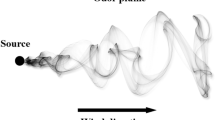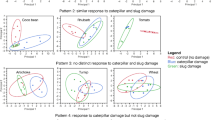Abstract
Powerful volatile regulators of gene expression, pheromones and other airborne signals are of great interest in biology. Plants are masters of volatile production and release, not just from flowers and fruits, but also from vegetative tissues. The controlled release of bouquets of volatiles from leaves during attack by herbivores helps plants to deter herbivores or attract their predators, but volatiles have other roles in development and in the control of defence gene expression. Some of these roles may include long-distance signalling within and perhaps between plants.
This is a preview of subscription content, access via your institution
Access options
Subscribe to this journal
Receive 51 print issues and online access
$199.00 per year
only $3.90 per issue
Buy this article
- Purchase on Springer Link
- Instant access to full article PDF
Prices may be subject to local taxes which are calculated during checkout


Similar content being viewed by others
References
Bleeker, A. B. & Kende, H. Ethylene: a gaseous signal molecule in plants. Ann. Rev. Cell Dev. Biol. 16, 1–18 (2000).
Walling, L. L. The myriad plant responses to herbivores. J. Plant Growth Reg. 19, 195–216 (2000).
Turlings, T. C. J & Tumlinson, J. H. Systemic release of chemical signals by herbivore-injured corn. Proc. Natl Acad. Sci. USA 89, 8399–8402 (1992).
Alborn, H. T. et al. An elicitor of plant volatiles from beet armyworm oral secretion. Science 276, 945–949 (1997).
Kessler, A. & Baldwin, I. T. Defensive function of herbivore-induced plant volatile emissions in nature. Science 291, 2141–2144 (2001).
De Moraes, C. M., Mescher, M. C. & Tumlinson, J. H. Caterpillar-induced nocturnal plant volatiles repel conspecific females. Nature 410, 577–580 (2001).
Dicke, M. & Bruin, J. (eds) Chemical information transfer between wounded and unwounded plants. Biochem. Syst. Ecol. 29 (2001).
Pickett, J. A. & Poppy, G. M. Switching on plant genes by external chemical signals. Trends Plant Sci. 6, 137–139 (2001).
Knoester, M. et al. Ethylene-insensitive tobacco lacks nonhost resistance against soil-borne fungi. Proc. Natl Acad. Sci. USA 95, 1933–1937 (1998).
Shulaev, V., Silverman, P. & Raskin, I. Airborne signalling by methyl salicylate in plant pathogen resistance. Nature 385, 718–721 (1997).
Creelman, R. A. & Mullet, J. E. Biosynthesis and action of jasmonates in plants. Annu. Rev. Plant Physiol. Plant Mol. Biol. 48, 355–387 (1997).
Reymond, P. & Farmer, E. E. Jasmonate and salicylate as global signals for defense gene expression. Curr. Opin. Plant Biol. 1, 404–411 (1998).
Seo, H. S. et al. Jasmonic acid carboxyl methyltransferase: a key enzyme for jasmonate-regulated plant responses. Proc. Natl Acad. Sci. USA 98, 4788–4793 (2001).
Farmer, E. E. & Ryan, C. A. Interplant communication: airborne methyl jasmonate induces synthesis of proteinase inhibitors in plant leaves. Proc. Natl Acad. Sci. USA 87, 7713–7716 (1990).
Bruin, J., Sabelis, M. W. & Dicke, M. Do plants tap SOS signals from their infested neighbours? Trends Ecol. Evol. 10, 167–170 (1995).
Shonle, I. & Bergelson, J. Interplant communication revisited. Ecology 76, 2660–2663 (1995).
Karban, R., Baldwin, I. T., Baxter, K. J., Laue, J. G. & Felton, G. W. Communication between plants: induced resistance in wild tobacco plants following clipping of neighboring sagebrush. Oecologia 125, 66–71 (2000).
Bruin, J., Dicke, M. & Sabelis, M. W. Plants are better protected against spider-mites after exposure to volatiles from infested conspecifics. Experentia 48, 525–529 (1992).
Arimura, G.-I. et al. Herbivory-induced volatiles elicit defense genes in lima bean leaves. Nature 406, 512–515 (2000).
Koch, T., Bandemer, K. & Boland, W. Biosynthesis of cis-jasmone: a pathway for the inactivation and the disposal of the plant stress hormone jasmonic acid to the gas phase? Helv. Chim. Acta 80, 838–850 (1997).
Birkett, M. A. et al. New roles for cis-jasmone as an insect semiochemical and in plant defense. Proc. Natl Acad. Sci. USA 97, 9329–9334 (2000).
Loreto, F. & Sharkey, T. D. Isoprene emission by plants is affected by transmissible wound signals. Plant Cell Environ. 16, 563–570 (1993).
Logan, B. A., Monson, R. K. & Potosnak, M. J. Biochemistry and physiology of foliar isoprene production. Trends Plant Sci. 5, 477–481 (2000).
Baldwin, I. T. & Schultz, J. C. Rapid changes in tree leaf chemistry induced by damage: evidence for communication between plants. Science 221, 277–279 (1983).
Rhoades, D. F. in Plant Resistance to Insects (ed. Hedin, P.) 55–68 (Am Chem. Soc., Washington DC, 1983).
Haujioka, E., Suomela, J. & Neuvonen, S. Long-term inducible resistance in birch foliage: triggering cues and efficacy on a defoliator. Oecologia 65, 363–369 (1985).
Fujiwara, M., Oku, H. & Shiraishi, T. Involvement of volatile substances in systemic resistance of barley against Erysiphe graminis f. sp. hordei induced by pruning leaves. J. Phytopath. 120, 81–84 (1987).
Dolch, R. & Tscharntke, T. Defoliation of alders (Alnus glutinosa) affects herbivory by leaf beetles on undamaged neighbours. Oecologia 125, 504–511 (2000).
Rhoades, D. F. Pheromonal communication between plants. Rec. Adv. Phytochem. 19, 195–218 (1985).
Croft, K. P. C., Jüttner, F. & Sluzarenko, A. J. Volatile products of the lipoxygenase pathway evolved from Phaseolus vulgaris (L.) leaves inoculated with Pseudomonas syringae pv phaseolicola . Plant Physiol. 101, 13–24 (1993).
Lyr, H. & Banasiak, L. Alkenals, volatile defense substances in plants, their properties and activities. Acta Phytopath. Acad. Sci. Hung. 18, 3–12 (1983).
Zeringue, H. J. Jr Effects of C6-C10 alkenals and alkanals on eliciting a defense response in the developing cotton boll. Phytochem. 31, 2305–2308 (1992).
Bate, N. J. & Rothstein, S. J. C6-volatiles derived from the lipoxygenase pathway induce a subset of defense-related genes. Plant J. 16, 561–569 (1998).
Vollenweider, S., Weber, H., Stolz, S., Chételat, A. & Farmer, E. E. Fatty acid ketodienes and fatty acid ketotrienes: Michael addition acceptors that accumulate in wounded and diseased Arabidopsis leaves. Plant J. 24, 467–476 (2000).
Thaler, J. S. Jasmonate-inducible plant defences cause increased parasitism of herbivores. Nature 399, 686–688 (1999).
Author information
Authors and Affiliations
Corresponding author
Rights and permissions
About this article
Cite this article
Farmer, E. Surface-to-air signals. Nature 411, 854–856 (2001). https://doi.org/10.1038/35081189
Issue Date:
DOI: https://doi.org/10.1038/35081189
This article is cited by
-
RBOH play regulatory role in the JA pathway induced by the volatile organic compound ethyl vinyl ketone
Plant Growth Regulation (2023)
-
On the qualitative study of a two-trophic plant–herbivore model
Journal of Mathematical Biology (2022)
-
Qualitative analysis of a discrete-time phytoplankton–zooplankton model with Holling type-II response and toxicity
Advances in Difference Equations (2021)
-
Using β-ocimene to increase the artemisinin content in juvenile plants of Artemisia annua L.
Biotechnology Letters (2020)
-
Plant neighbor detection and allelochemical response are driven by root-secreted signaling chemicals
Nature Communications (2018)
Comments
By submitting a comment you agree to abide by our Terms and Community Guidelines. If you find something abusive or that does not comply with our terms or guidelines please flag it as inappropriate.



